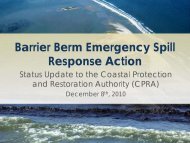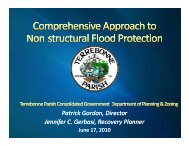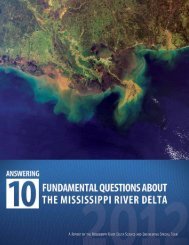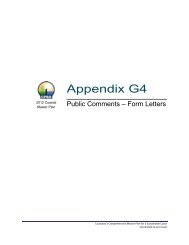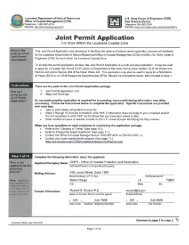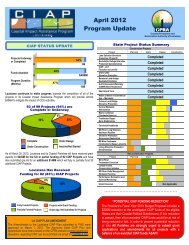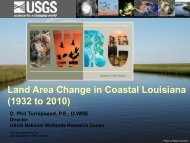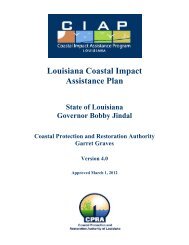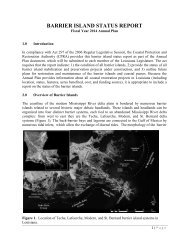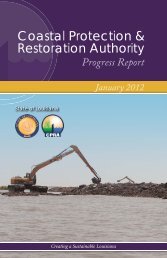Largemouth Bass Habitat Suitability Index Technical Report
Largemouth Bass Habitat Suitability Index Technical Report
Largemouth Bass Habitat Suitability Index Technical Report
Create successful ePaper yourself
Turn your PDF publications into a flip-book with our unique Google optimized e-Paper software.
APPENDIX D‐9 LARGEMOUTH BASS HABITAT SUITABILITY INDEX TECHNICAL REPORT<strong>Suitability</strong> <strong>Index</strong>10.90.80.70.60.50.40.30.20.100 10 20 30 40 50 60Chlorophyll a (ug/L)Figure 5. The relationship between chlorophyll a with the suitability index.b. Description of system being represented by the modelThis model predicts how suitable the habitat for largemouth bass is in a given cell per year. Itdoes not predict density or abundance. This model addresses aquatic habitat only and primarilyreflects the freshening or salinization of aquatic habitats. Although salinity is the principal driverof the model, the influence of salinity is modified by temperature and vegetation variables thatreduce habitat suitability when habitat is poor or temperatures are extreme, even if salinity issuitable. As suitability approaches 1, salinity is within tolerable ranges, vegetation andchlorophyll a, are appropriate, and temperatures are not extreme. Only salinity may drivesuitability to 0 and other variables may only force suitability to very low values.This model is dependent on temperature, salinity, chlorophyll a, and vegetation variables. Anyuncertainty in these input variables will be reflected in this model output. Additional discussionof uncertainty and model limitations is included in Sections 5 and 7.c. Analytical requirementsThe largemouth bass HSI has the following analytical requirements: 1) food availability asdescribed by emergent vegetation (SI 1 ) and chlorophyll a (SI 7 ); 2) cover as described byemergent vegetation (SI 1 ) and submersed aquatic vegetation (SI 6 ); 3) water quality as describedby temperature (SI 2 ), salinity (SI 3 ), and chlorophyll a (SI 7 ); and 4) reproduction as described bytemperature (SI 2 ). Because this HSI is based on Stuber’s (1982) HSI, 0 to 1 suitability indicesderived from the variables are actually incorporated in the HSI. Each 0 to 1 suitability index isderived from the variables following the decision rules associated with Figures 1 through 5 inthis document. The suitability index values for each variable are multiplied with the othervariables in the groups of food, cover, and water quality, and these products represents the rawsuitability of a given cell or polygon with regard to the variables. In the reproduction group, thesuitability index is simply the value from temperature. Because food, cover, water quality, andreproduction contribute equally to the HSI, each product of variable multiplication is weightedsuch that the products are equal. Unequal number of variables in each product unbalance theLouisiana’s Comprehensive Master Plan for a Sustainable CoastPage 11



